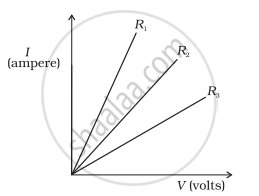Advertisements
Advertisements
Question
Name the law which is illustrated by the above V−I graph.
Solution
Ohm's law is illustrated by the above V−I graph.
APPEARS IN
RELATED QUESTIONS
Why are coils of electric toasters and electric irons made of an alloy rather than a pure metal?
Fill in the following blank with suitable words:
Resistance is measured in .............. The resistance of a wire increases as the length ..............; as the temperature ..............; and as the cross-sectional area .............. .
The resistors R1, R2, R3 and R4 in the figure given below are all equal in value.

What would you expect the voltmeter A, B and C to read assuming that the connecting wires in the circuit have negligible resistance?
What is non ohmic device?
Define temperature coefficient of resistance.
The unit of specific resistance is ____________.
A student carries out an experiment and plots the V-I graph of three samples of nichrome wire with resistances R1, R2 and R3 respectively. Which of the following is true?

A metal rod of length 10 cm and a rectangular cross-section of 1 cm × `1/2` cm is connected to a battery across opposite faces. The resistance will be ______.
You are provided with a resistor, a key, an ammeter, a voltmeter, four cells of 1.5 V each and few connecting wires. Using circuit components, draw a labelled circuit diagram to show the setup to study Ohm's law.
State the relationship between potential difference (V) across the resistor and the current (I) flowing through it. Also draw V-I graph, taking V on the X-axis.
Why should an ammeter have low resistance?
